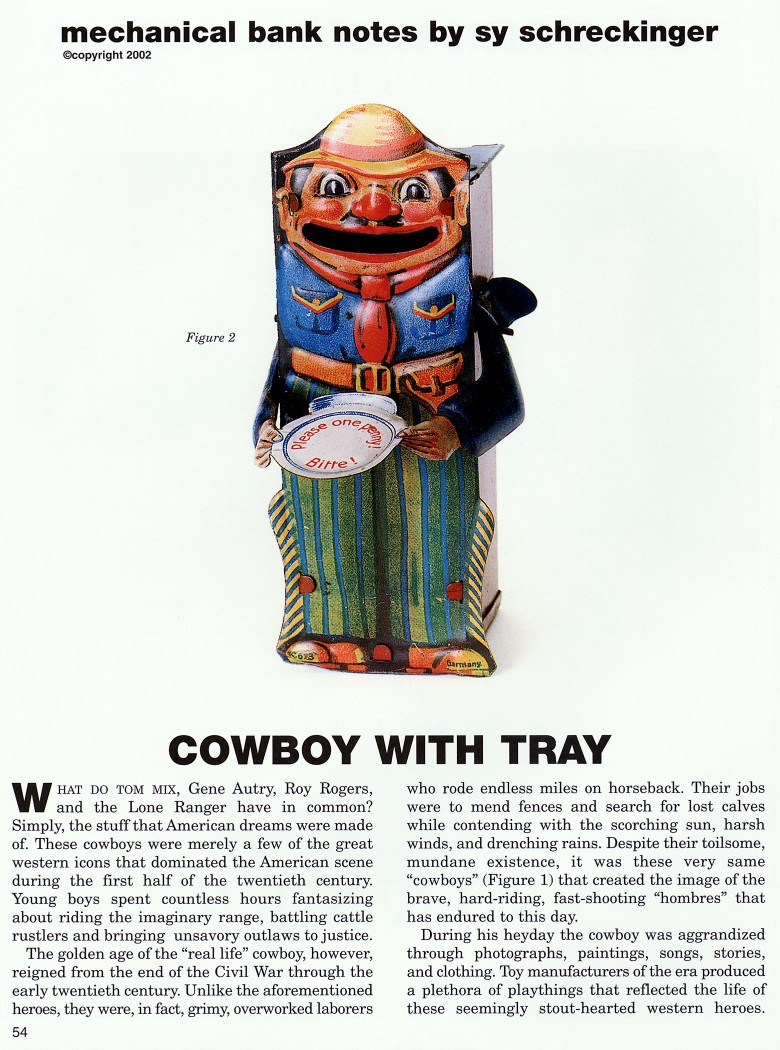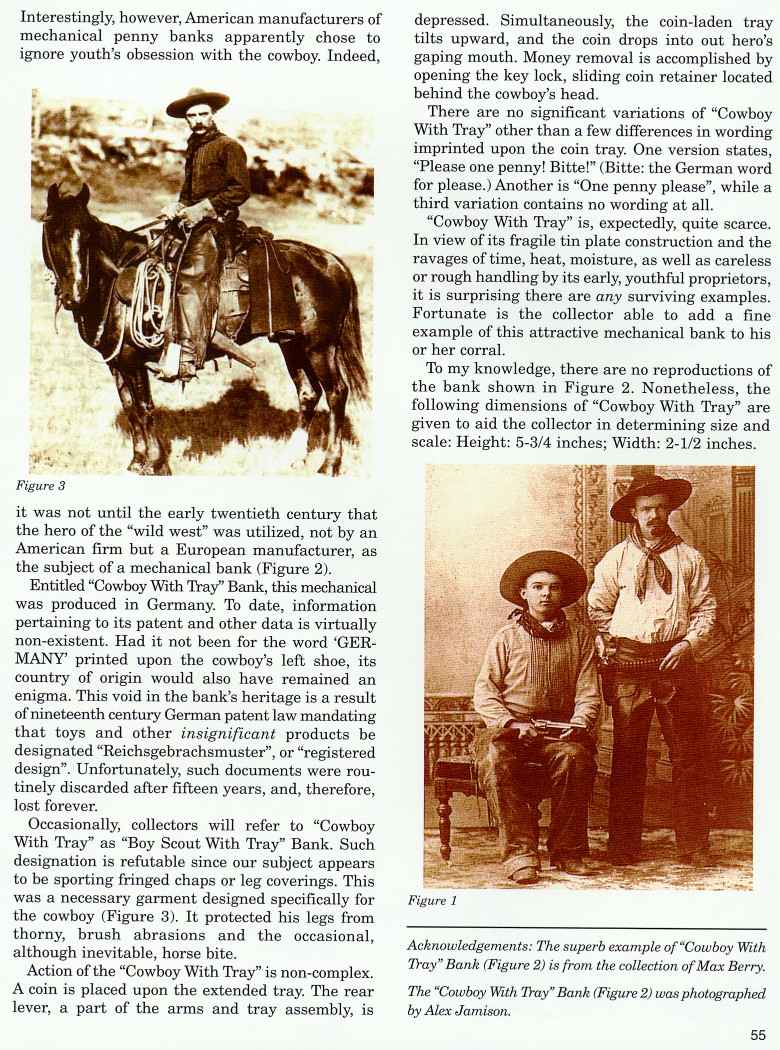|
Cowboy with Tray
by Sy Schreckinger – ANTIQUE TOY WORLD Magazine – July, 2002
What do Tom Mix, Gene Autry, Roy Rogers, and the
Lone Ranger have in common? Simply, the stuff that American dreams were
made of. These cowboys were merely a few of the great western icons that
dominated the American scene during the first half of the twentieth
century. Young boys spent countless hours fantasizing about riding the
imaginary range, battling cattle rustlers and bringing unsavory outlaws to
justice.
The golden age of the "real life" cowboy, however, reigned from the
end of the Civil War through the early twentieth century. Unlike the
aforementioned heroes, they were, in fact, grimy, overworked laborers who
rode endless miles on horseback. Their jobs were to mend fences and search
for lost calves while contending with the scorching sun, harsh winds, and
drenching rains. Despite their toilsome, mundane existence, it was these
very same "cowboys" (Figure 1) that created the image of the brave,
hard-riding, fast-shooting "hombres" that has endured to this day.
During his heyday the cowboy was aggrandized through photographs,
paintings, songs, stories, and clothing. Toy manufacturers of the era
produced a plethora of playthings that reflected the life of these
seemingly stout-hearted western heroes.
Interestingly, however, American manufacturers of mechanical penny
banks apparently chose to ignore youth's obsession with the cowboy.
Indeed, it was not until the early twentieth century that the hero of the
"wild west" was utilized, not by an American firm but a European
manufacturer, as the subject of a mechanical bank (Figure 2).
Entitled "Cowboy With Tray" Bank, this mechanical was produced in
Germany. To date, information pertaining to its patent and other data is
virtually non-existent. Had it not been for the word 'GERMANY' printed
upon the cowboy's left shoe, its country of origin would also have
remained an enigma. This void in the bank's heritage is a result of
nineteenth century German patent law mandating that toys and other
insignificant products be designated "Reichsgebrachsmuster", or
"registered design". Unfortunately, such documents were routinely
discarded after fifteen years, and, therefore, lost forever.
Occasionally, collectors will refer to "Cowboy With Tray" as "Boy
Scout With Tray" Bank. Such designation is refutable since our subject
appears to be sporting fringed chaps or leg coverings. This was a
necessary garment designed specifically for the cowboy (Figure 3). It
protected his legs from thorny, brush abrasions and the occasional,
although inevitable, horse bite.
Action of the "Cowboy With Tray" is non-complex. A coin is placed
upon the extended tray. The rear lever, a part of the arms and tray
assembly, is depressed. Simultaneously, the coin-laden tray tilts upward,
and the coin drops into out hero's gaping mouth. Money removal is
accomplished by opening the key lock, sliding coin retainer located behind
the cowboy's head.
There are no significant variations of "Cowboy With Tray" other than
a few differences in wording imprinted upon the coin tray. One version
states, "Please one penny! Bitte!" (Bitte: the German word for please.)
Another is "One penny please", while a third variation contains no wording
at all.
"Cowboy With Tray" is, expectedly, quite scarce. In view of its
fragile tin plate construction and the ravages of time, heat, moisture, as
well as careless or rough handling by its early, youthful proprietors, it
is surprising there are any surviving examples. Fortunate is the collector
able to add a fine example of this attractive mechanical bank to his or
her corral.
To my knowledge, there are no reproductions of the bank shown in
Figure 2. Nonetheless, the following dimensions of "Cowboy With Tray" are
given to aid the collector in determining size and scale: Height: 5-3/4
inches; Width: 2-1/2 inches.
Acknowledgements: The superb example of "Cowboy With Tray" Bank
(Figure 2) is from the collection of Max Berry.
The "Cowboy With Tray" Bank (Figure 2) was photographed by Alex
Jamison.
|


